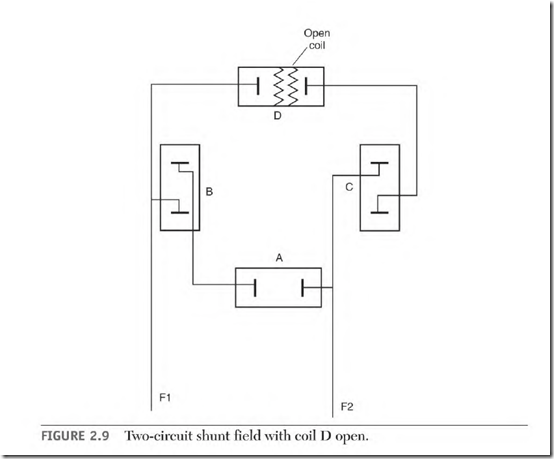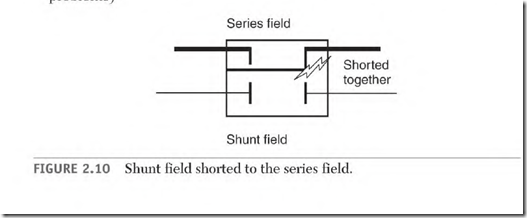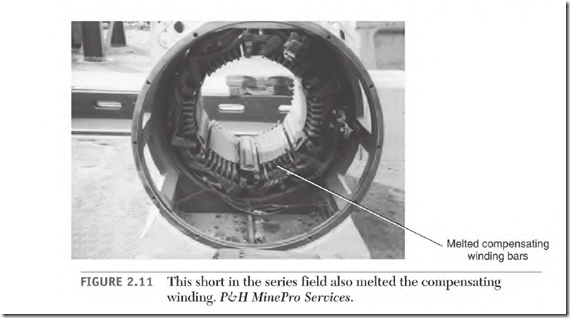The term machine is used when both motors and generators use the same procedure. Motor or generator is used when the explanation applies to one or the other.
The following test procedures are designed to quickly test DC machines in place. These tests identify the problem and determine if the machine should be removed, can be repaired in place, or can continue to operate as is. The text describes the circuitry of a compound machine. The shunt field and armature use the same test, respectively, in all types of machines. A series motor’s field coils may have many more turns than the series field of a compound machine and can be tested like a shunt winding. All test information should be recorded.
Field Testing the Armature
The right size ohmmeter or a limited DC current and an ammeter can be used to check the armature (while the machine is in place). This test can be done from the machine’s control.
Connect the test equipment to Al and A2. Rotate the armature slowly, noting the reading. The value will change as the armature rotates. There will be a high and low reading. It may vary (but should repeat the same variance)
during a complete revolution. (Any change indicates a problem and requires more detailed testing.)
An armature can be tested in place to determine if a motor needs to be removed and repaired. Uncouple the load and lift all the brushes. Apply fullrated voltage to the shunt field, and rotate the shaft. There will be more drag when the shunt field is energized. If the drag is hard and uneven, there is a short in the armature winding.
Shorted turns form a closed-loop circuit. The turns within this circuit generate a voltage and current as they cut the shunt field lines of force. The power that the loop circuit creates requires torque, the same as a generator. The retarding torque is uneven because it happens only as the shorted turns pass a stator pole.
This test can be simulated using a motor that has no problem. Lift the brushes and short two commutator bars together. TUrn the shaft before and after applying rated voltage to the shunt field. This procedure gives a feel for what to expect when field testing a real short.
Field Testing for Grounds in the Armature Circuit with an Ohmmeter
Leads Al and A2 include the brush holder and interpoles. A test for ground should be done from Al or A2 to the shaft and to the frame with a multimeter set on ohms. The machine’s bearings shouldn’t be included in a test circuit using amperes (such as a microhmmeter has).
A solid ground in the armature would require rewinding. An indication of
1 megohm or less requires further testing.
A low reading of I to 50 megohms can sometimes be increased by cleaning and drying the machine.
Field Testing the Shunt Field
All test information should be recorded and available for future comparison. The shunt field leads Fl and F2 should be disconnected from the armature circuit for the following tests. Problems in the shunt field are
Ground to the Frame Symptoms
The following are ground to the frame symptoms:
![]() Higher than nameplate amperes if more than one coil is shorted to ground
Higher than nameplate amperes if more than one coil is shorted to ground
![]() Some shunt field coils get hotter than others
Some shunt field coils get hotter than others
Field Test Using an Ohmmeter to Test for Ground in Shunt Field Be sure the power is disconnected and that shunt field leads Fl and F2 aren’t connected to the armature circuit.
A reading 5 percent or more lower than the expected value indicates the shunt field coils should be tested further.
Field Test Using an Ammeter to Test a Shorted Shunt Field Apply the nameplate-rated DC voltage to the shunt field leads Fl and F2. There could be shorted turns if the reading is above the shunt field’s (nameplate) amp rating.
Allow the field to warm to its normal running temperature if the amperes are 5 percent or less above the nameplate value. (Nameplate amperes assume the machine is at normal running temperature.) Copper gains resistance as its heat increases. The amperes will drop to normal as the machine reaches its operating temperature.
Open Shunt Field Symptoms
The following are open shunt field symptoms:
![]() High amperes in armature circuit at any speed
High amperes in armature circuit at any speed
 If the shunt field circuit is open while the motor is running with no load, it will dangerously overspeed and damage or destroy the armature components.
If the shunt field circuit is open while the motor is running with no load, it will dangerously overspeed and damage or destroy the armature components.
Field Test with an Ohmmeter for an Open Circuit in a One-Circuit Shunt Field Make sure the power is disconnected and that the shunt field leads Fl and F2 aren’t connected to the armature circuit. There will be no ohmmeter reading (infinity) between Fl and F2 if the circuit is open. Test to the frame with both Fl and F2 for a ground.
Field Test with an Ohmmeter for an Open Circuit in a Parallel Circuit Shunt Field Make sure the power is disconnected and that the shunt field leads Fl and F2 aren’t connected to the armature circuit.
If the machine has more than one circuit in its shunt field, an open would have more resistance than normal between Fl and F2 (Fig. 2.9).
Determine the resistance of the shunt field. (If the resistance is not given on the nameplate, divide the shunt field voltage by its amperes.) If tests from Fl to F2 show a higher resistance than expected, one of the circuits is open. A two-circuit connection would have double the expected resistance. If there were three circuits, the resistance would be 1.5 times the expected resistance. (The more circuits in the shunt field, the smaller the difference.) Test to the frame with both Fl and F2 for a ground.
Shunt Field Shorted to the Series Field Symptoms
The following are shunt field shorted to the series field symptoms:
Field Test with an Ohmmeter for the Shunt Field Shorted to the Series Field Make sure the power is disconnected and that the shunt field leads Fl and F2 are not connected to any other circuit. If there is no short, a test from Fl to Sl will read infinity.
In smaller machines, the series coil is wound on top of the shunt coil, with insulation separating them. Overloading is a common cause of insulation breakdown between the two fields (Fig. 2.10). An overload overheats the series field, deteriorating and eventually charring the separating insulation. This problem requires rewinding all the field coils.
If the machine hasn’t been overheated and the reading is 50 megohms or less, cleaning and drying should make an improvement.
Field Testing the Series Field
For this testing, the series field leads (Sl and S2) are connected in series with the armature and interpoles.
Problems in the series field include
![]() Series field shorted to the shunt field (also covered under shunt field problems)
Series field shorted to the shunt field (also covered under shunt field problems)
Ground to the Frame Symptoms
The following are the symptoms of a ground to the frame:
• No symptoms (unless more than one coil is grounded)
• Touching the machine gives a shock
• High amperes in armature
• Loss of power
• Arcing at some brushes
• Frequent ball bearing failure
Field Test Using an Ohmmeter to Test for Ground in Series Field The series field coil is usually wound on top of the shunt field coil. In some machines, it’s a separate coil.
Be sure the power is disconnected. Disconnect the series field leads Sl and S2.
Secure one ohmmeter probe to the machine’s frame, making good electrical contact. Then, touch Sl with the other probe. No problem would read near infinity. A reading (nearly the same as touching the probes together) indicates a serious ground.
If the coils are loose on the pole iron, a faulty coil may not make continuous contact to the frame. Move all the coils while the test probes are in place. (Field coils should be tightly secured on the pole iron and have no movement.) Loose coils eventually wear through the insulation, causing electrical contact to the pole iron. If there is a low reading of 50 megohms or less, cleaning and drying should make an improvement.
Shorted Turns in Series Field Symptoms
The following symptoms indicate shorted turns in the series field:
• Loss of power output
• Arcing at some or all brushes
• Output not responding to load changes
Field Test for Shorted Turns in Series Field The series field is a high-ampere circuit (with large wire). The location of an open, a ground, or shorted turns is usually very obvious. When a fault occurs, there is major arcing, melted wire, and scorched insulation in the fault area, as seen in Fig. 2.11.
A shunt field with the same faults will not cause as much damage. Its small wire will melt and open its circuit, with fewer amperes and less arcing.
Operate the machine loaded (with the series field) and check for symptoms described above. Next, operate the machine without the series field. It will now operate as a shunt-wound machine.
If the machine is a motor, the RPM will drop some when the load is applied. If it’s a generator, the voltage will drop some as the load is applied.
Brush arcing will be normal.
If the machine’s series field is multicircuit, there will be a large magnetic imbalance. Some (not all) brushes will arc excessively. Arcing will increase as the load increases.
Shorted turns in the series field are hard to locate without opening the machine. The voltage drop test across each coil is the surest way to detect this problem. This requires accessing the connections between coils.
Open Series Field Symptoms
The following symptoms indicate an open series field:
• One-circuit series field
• Motor: Will not run.
• Generator: No voltage across Al and Sl. There will be full voltage across Al and A2.
• Multicircuit series field
• Motor: Runs normally with no load, but RPM drops and some brushes arc excessively when loaded.
• Generator: Full-voltage output with no load but voltage drops and some brushes arc excessively when loaded.
Field Test for Open Series Field by Operating Without the Series Field Disconnect Sl and S2. Operate the machine as a shunt motor or generator. It should operate as a shunt machine, without the stabilizing effect of the series field.
A motor will slow down as the load is added. A generator’s voltage output will drop as the load is added.
Field Test with an Ohmmeter for Open Series Field Be sure the power is disconnected and that series field leads Sl and S2 aren’t connected to any other circuit. A one-circuit series field will read infinity across Sl and S2.
A multicircuit series field requires disassembling the machine and opening the connections. This is described later in the chapter under “Locating an Open Circuit in Series Field.’![]()
Series Field Shorted to the Shunt Field
A test between Fl and Sl with an ohmmeter should read infinity. A reading as high as 1 megohm indicates a potentially serious problem.
The series field is wound on top of the shunt field with a layer of insulation between. This insulation must withstand the pressure of winding large series coil wire tightly around the shunt coil. It also must withstand the thermal growth stress caused by heating and cooling of the series coil. An insulation breakdown usually blows the shunt field open, and makes a very visible burned spot on the coil.
The voltage difference between the two circuits can be the value of the applied voltage.


